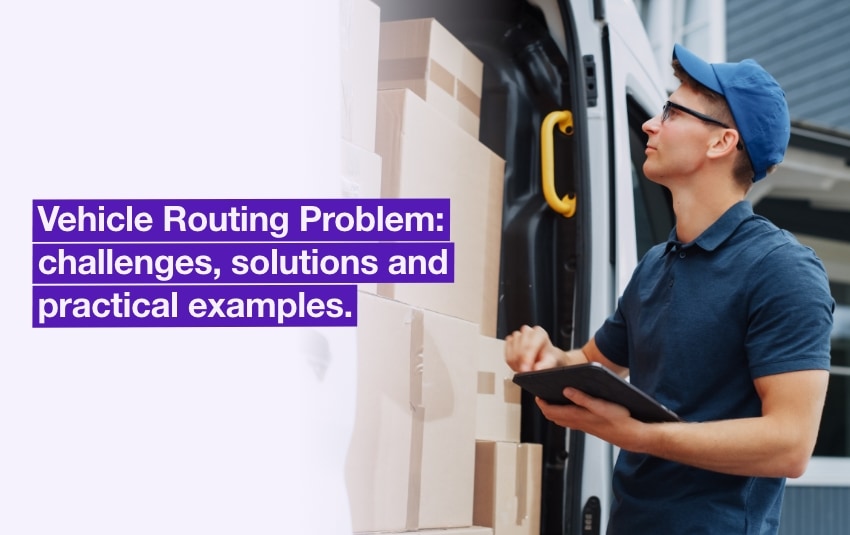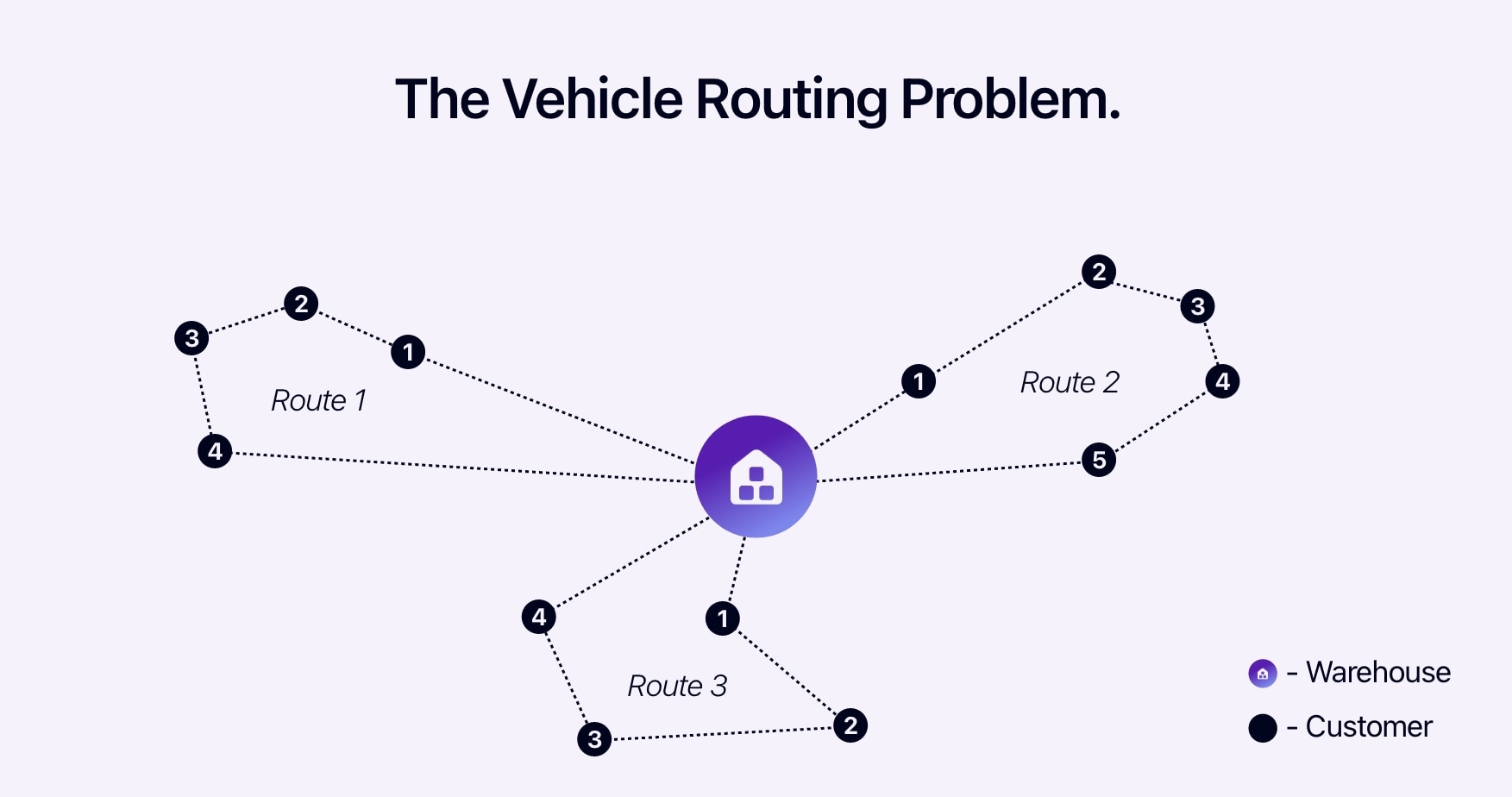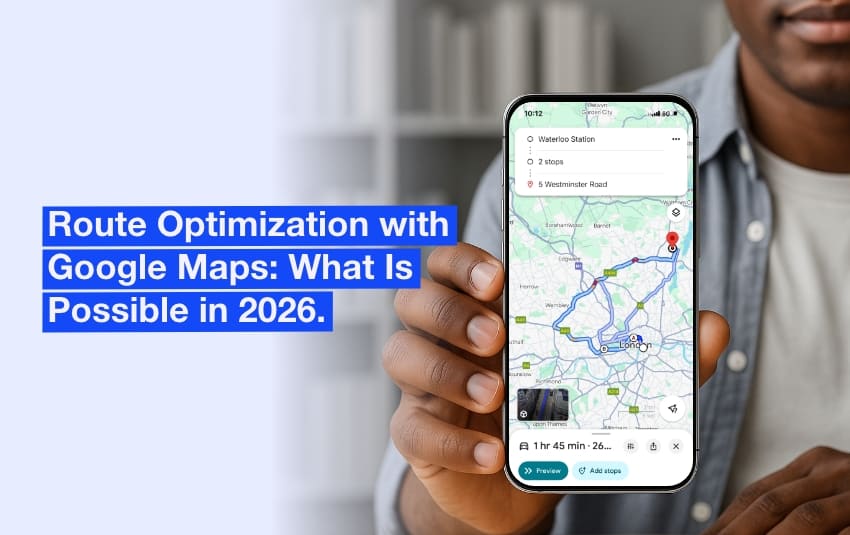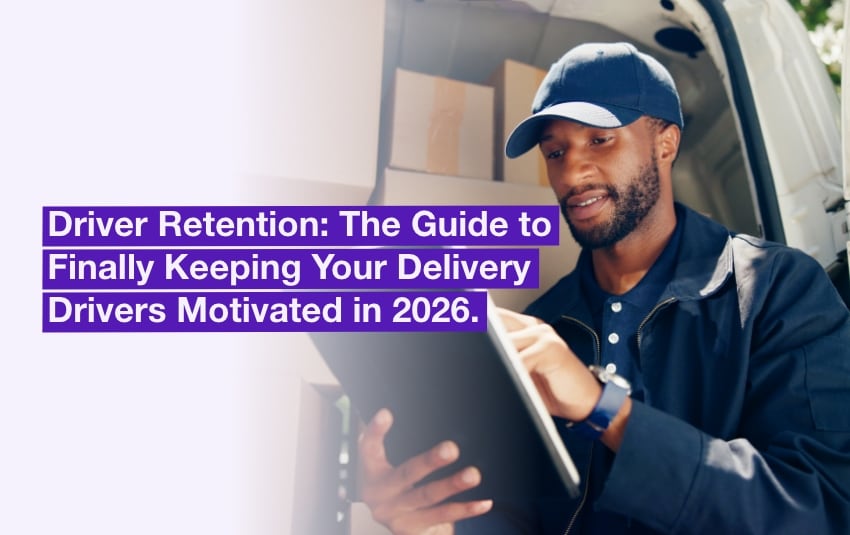Vehicle routing problem: challenges, solutions and practical examples

If you work in the delivery industry, you know that managing a fleet of vehicles and organising efficient routes is no easy task. The Vehicle Routing Problem (VRP) is a major challenge for any delivery company. You need to determine the best routes for your vehicles, in order to deliver your parcels at the lowest cost, while respecting the constraints associated with customer time slots, vehicle capacity and road restrictions. And with the boom in e-commerce and consumer expectations, it’s no longer possible to ignore route optimisation.
- The Vehicle Routing Problem: What is it?
- The Different Types of Vehicle Routing Problems
- The Practical Challenges of the VRP (Vehicle Routing Problem)
- What are the Solutions for Solving Vehicle Routing Problems?
- Practical Example: a Delivery Company in Oxford
The vehicle routing problem is a complex challenge for delivery companies. By optimising routes, you can cut costs and meet customer deadlines. It’s a winning strategy for standing out in a competitive environment.
The Vehicle Routing Problem: What is it?
The VRP was first studied in the 1950s. But it has its roots in an older issue: the travelling salesman problem.
This complex mathematical problem involves finding the best possible distribution and routes for a fleet of vehicles. The aim is to minimise costs, whether in terms of distance travelled, time or fuel consumed, while complying with a set of specific constraints such as customer requirements and vehicle capacity.
Imagine you’re managing a fleet of 10 vehicles, each of which has to deliver 200 parcels to a major British city. Each vehicle has a maximum carrying capacity, and each customer has a specific time window during which they can receive their parcel. You have to find the best route for each vehicle, while respecting the constraints and optimising costs. There’s nothing easy about that. This challenge becomes even more complex as the number of customers, vehicles and constraints increases.

The vehicle routing problem (VRP).
The Different Types of Vehicle Routing Problems
The VRP can take different forms, depending on the specific characteristics of your company and your fleet.
There are 4 main types of problems:
- Vehicle Routing Problem with Time Windows (VRPTW): Your customers cannot receive their parcels at any time. They have specific time slots. Imagine, for example, that you have to deliver parcels for FedEx in London. Your customers expect their delivery within a 1-hour window between 9am and 10am. If your vehicles get stuck in traffic jams or are badly organised, you risk delays, complaints and even penalties.
- Capacitated Vehicle Routing Problem (CVRP): Each vehicle in your fleet has a limited carrying capacity, in terms of volume or weight. You need to maximise the use of each vehicle, without exceeding its capacity. If you don’t, you risk having to make unnecessary return trips, which increases your costs and reduces your efficiency.
- Pick-up and Delivery Vehicle Routing Problem (PDVRP): Sometimes your vehicles not only have to deliver parcels, but also collect others on the way home. This is a common scenario for companies like Uber, where drivers have to drop off and pick up passengers, while minimising the distances travelled.
- Multi-Depot Vehicle Routing Problem (MDVRP): If your company has several depots or distribution centres, route planning becomes even more complex. You need to coordinate departures from several locations and optimise routes to reduce costs as much as possible. This type of VRP is common in large distribution chains.

The different types of vehicle routing problems.
The Practical Challenges of the VRP (Vehicle Routing Problem)
In addition to delivery times, the capacity of your vehicles and multiple pickup points, you may encounter other types of problem linked to fluctuating demand or the availability of your drivers.
If your routes aren’t properly managed, you can end up using too much fuel, your vehicles wear out prematurely and you take longer to deliver your goods. By optimising your routes, you can improve the speed and reliability of your deliveries, and therefore customer satisfaction. But you can also reduce your fuel costs by up to 20%. And it’s not just a question of profitability: it’s also an environmental issue, especially in big cities where traffic jams increase CO2 and fine particle emissions. According to a McKinsey study, emissions from urban delivery could rise by 32% by 2030 in the world’s 100 largest cities if nothing is done.
More and more delivery companies are looking to minimise their costs and their carbon footprint, by opting for electric vehicles and eco-driving practices, grouping orders and optimising their routes.
But the more customers you have to deliver to, the more complex route planning becomes. Each additional customer multiplies the possible combinations for your routes, making the task virtually impossible to manage manually. For example, if you have a fleet of 50 vehicles delivering 1,000 parcels across a large city like London or Paris, route planning becomes a real headache. Traffic hazards, accidents, weather conditions and other unforeseen events are all part of your drivers’ daily routine. To minimise delays and optimise deliveries, you need to be able to adjust your routes in real time. For example, if a traffic jam occurs on the London ring road, your vehicles must immediately be redirected to alternative routes to avoid delays.
To sum up this complexity, here are the four essential parameters to take into account when solving the problems associated with your vehicle routes:
Number of possible combinations + Operational and environmental costs + Real-time adaptability + Customer satisfaction

The 4 parameters to be taken into account to solve the vehicle routing problem.
What are the Solutions for Solving Vehicle Routing Problems?
To solve the vehicle routing problem, various approaches have been developed over the years, ranging from traditional methods to modern technology-based solutions.
Traditional approaches
1. Manual planning
For decades, companies planned their routes manually. This involved the use of paper maps, customer lists and a great deal of experience in the field. While this method may work for small operations, it quickly becomes unworkable when the amount of data to be processed increases. It is also prone to human error, sometimes with very costly consequences.
2. Heuristic routing
Some companies have adopted heuristic methods to simplify route planning. The heuristics are simple rules based on experience. They allow approximate solutions to be found, which can be quickly calculated. For example, a heuristic might be to always deliver to the nearest customers first. This approach is more efficient than manual planning, but it is not optimal and can still lead to additional costs.
Advanced approaches
1. Route optimisation software
Route optimisation software automatically calculates the best routes for your vehicles. It takes into account all constraints (time windows, timetables, vehicle capacity, traffic conditions, etc.).
Some route optimisation software also includes dynamic re-optimisation, so that routes can be adjusted in real time to take into account unforeseen circumstances. If a customer cancels an order or a traffic jam occurs, the software can immediately reorganise deliveries to minimise disruption.
The DHL company has reportedly managed to save up to 20% on its delivery costs thanks to dynamic routing algorithms.
The AntsRoute software, which you can adopt, offers similar solutions by adapting routes in real time.

The AntsRoute route optimisation software interface.
2. Artificial Intelligence (AI)
Artificial Intelligence is a major asset for optimising routes. It allows the prediction of unforeseen events (traffic jams, accidents, etc.) and the adjustment of routes accordingly. By integrating AI into its route management system, Tesco is said to have reduced the distances travelled by its vehicles by 11.2 million kilometres, while saving 8% on fuel per order.
3. Predictive analysis
The analysis of both past and current data also helps you to plan the best routes. By anticipating peak periods, weather conditions and exceptional events (such as strikes or other major events), you can adjust your delivery strategies to avoid delays.
Practical Example: a Delivery Company in Oxford
Let’s take the example of a delivery company operating in a provincial city like Oxford. Oxford, located in the north-west of London, is a city with a historic centre with narrow streets, surrounding residential areas and more modern shopping areas. You’ll be managing around 300-400 deliveries a day. Here are the specific challenges you might face:
Typical delivery scenario
Your company needs to deliver to a number of areas in Oxford, from the historic city centre to residential areas such as Cumnor Hill, to the commercial areas of Westgate Oxford, Clarendon Centre Oxford or Bicester Shopping Park. Each area has its own constraints:
Constraint 1: Limited access to the town centre
Oxford Zero Emission Zone (ZEZ) has been operational since February 2022. The ZEZ results in restricted access for polluting vehicles between 7am and 7pm. Therefore, you need to plan your deliveries early in the morning or late at night, to avoid getting stuck.
Imagine you’ve got twenty or so parcels to deliver to Market Street, right in the centre of Oxford. The narrow streets and heavy pedestrian traffic make access difficult. Thanks to route optimisation software like AntsRoute, you can plan these deliveries at times when access is authorised and traffic is lighter, while respecting customers’ time slots.
Constraint 2: Traffic and parking in residential areas
The residential areas such as Cumnor Hill or Oxfordshire are often congested, particularly at school-leaving time or during the weekly markets. Parking is difficult, which can cause delays.
Imagine you have to deliver a dozen parcels in Oxfordshire on a Friday morning, market day. The streets involved are not very traffic-friendly, which complicates your route. With AntsRoute, you can plan your deliveries to avoid these traffic jams, by choosing less busy times or prioritising deliveries in less congested areas at that time. What’s more, in the event of delays, AntsRoute can readjust the order of deliveries in real time to minimise the impact on your route.
Constraint 3: Time windows in business zones
In areas like Milton Park or Catalyst Bicester, you’re dealing with businesses that operate to strict office hours. Deliveries have to be made between 9am and 5pm, which leaves you little room for manoeuvre. If a customer isn’t available outside these hours, you run the risk of missing the delivery and having to reschedule your route, which means extra costs.
With route optimisation software, you can prioritise deliveries according to customers’ specific time slots. For example, deliveries to Catalyst Bicester can be scheduled at the start of the day, to ensure that all packages are delivered on time. If a delivery takes longer than expected, software like AntsRoute’s can readjust the remaining route to avoid further delays.

AntsRoute enables deliveries to be prioritised according to customers’ specific time slots.
Constraint 4: Weather conditions
Oxford, like many other British cities, is subject to variable weather conditions. In winter, the city can experience heavy rainfall, making roads slippery and dangerous. These conditions can not only slow down your deliveries, but also increase the risk of accidents.
These weather forecasts can be integrated into your route planning. In the event of poor conditions, some software can suggest safer alternative routes or reorganise deliveries to reschedule them when conditions are better. This allows you to minimise risks and ensure the safety of your drivers, while meeting delivery deadlines.
Managing vehicle routes is a daily challenge for delivery companies, but it doesn’t have to be. With tools like AntsRoute’s route optimisation software, you can not only reduce costs, but also improve efficiency and customer satisfaction. Whether you operate in Oxford, London, Paris or elsewhere, route optimisation is essential to remain competitive in an increasingly demanding market.
The challenges you face, whether traffic jams, vehicle capacity, or time constraints, can all be overcome with the right technology. AntsRoute is an essential partner for any company looking to optimise its delivery operations. By investing in a route optimisation solution, you’re not just following a trend, you’re making a strategic decision to ensure the sustainability and growth of your business.
WRITTEN BY
Maryline Lakh
Maryline worked for a major logistics company for 15 years. Since 2022, she has been an expert in communication and freelance writer for positive-impact logistics companies. She is passionate about new sustainable logistics solutions and writes for several clients, including AntsRoute.
Free 7-day trial | No credit card required
Contenu
- The Vehicle Routing Problem: What is it?
- The Different Types of Vehicle Routing Problems
- The Practical Challenges of the VRP (Vehicle Routing Problem)
- What are the Solutions for Solving Vehicle Routing Problems?
- Traditional approaches
- 1. Manual planning
- 2. Heuristic routing
- Advanced approaches
- 1. Route optimisation software
- 2. Artificial Intelligence (AI)
- 3. Predictive analysis
- Practical Example: a Delivery Company in Oxford
- Typical delivery scenario
- Constraint 1: Limited access to the town centre
- Constraint 2: Traffic and parking in residential areas
- Constraint 3: Time windows in business zones
- Constraint 4: Weather conditions







